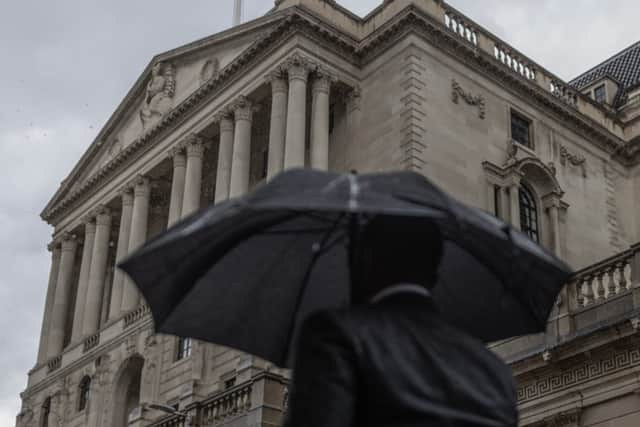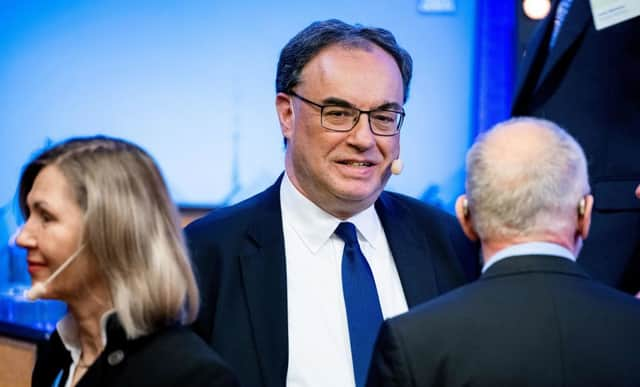What is the UK interest rate? Date of next Bank of England base rate decision and cost of living impact
and live on Freeview channel 276
The UK is braced for a further ratcheting up of interest rates next week when the Bank of England meets to decide its new base rate.
Already sitting at its highest level since the depths of the 2008 Financial Crisis, the rate has been climbing steeply since late 2021 as the country’s leading economists have sought to bring soaring inflation back under control.
While the rate of price rises fell further than expected in June, with the Consumer Prices Index (CPI) tumbling from 8.7% to 7.9%, the cost of living crisis is continuing to hit households. Not only is inflation still high, but other household bills have continued to get pricier - including mortgage rates, which are still rising despite the better inflation news.
The situation leave the Bank of England with a tough decision to make at its next interest rates meeting. While raising the rate again should in theory continue to bring down inflation, it may also bring about hardship in the form of a recession - an economic event that can lead to high unemployment.
So, what is the current UK interest rate - and what do economists expect the next decision to be?
What is the UK interest rate?
The Bank of England hiked interest rates for the 13th time in a row to a fresh 15-year high of 5% on 22 June. Analysts had expected another increase to the base rate as a result of yet another bad month of inflation data and strong wage growth. The rate is on a par with the peak seen during the last financial crisis.
The 0.5 percentage point hike by the economists on Threadneedle Street is part of the UK central bank’s bid to bring down inflation. However, it spelt immediate mortgage-related pain for households who sit on variable and tracker rate mortgages.


It comes as fixed rate mortgages have been spiking since May, when it became clear inflation has become more embedded in the UK economy than economists had initially expected. Rates have soared well above 6% on short-term mortgages, while lenders have also been pulling deals due to the rapid pace of change in the market.
When is the next interest rates decision?
The next rates decision is set to take place on Thursday 3 August. The Bank of England will inform the public of its latest decision at around midday.
The consensus at present is that the central bank will implement a 0.25 percentage point (25 basis point) hike next week. This would be smaller than the previous increase it announced, with commentators pointing to the better-than-expected inflation data as a reason for why it could be gentler.
Investment platform AJ Bell’s head of investment analysis, Laith Khalaf, said: “The Bank of England is expected to follow through with another rate rise at its forthcoming meeting, even though a sliver of space has opened up to allow them to pause the rate hiking cycle if they wanted to, with inflation falling back considerably in June. Of course, CPI is still way above target, so the Bank is likely to keep its foot on the brake pedal, even though that leads to mounting pressure on the UK’s beleaguered mortgage holders.”
Looking further ahead, the interest rates picture seems rosier, according to ING Economics developed markets economist James Smith. “The market-implied path for rates looks much more reasonable than it did just a couple of weeks ago,” he said.


“Investors thought rates could go as high as 6.5%. Now, it’s a little more than 5.75%, which implies three more 25 basis point (bp) rate hikes from the current 5% level. That seems fair, and while our formal forecast peaks a little below that at 5.5%, we acknowledge this is wholly dependent on further progress on services inflation and wages. That’ll determine whether we get a final 25bp hike in November, to follow the one we’re pencilling in for September.”
Independent analytical firm Capital Economics is also predicting a 25bp hike. Its chief UK economist Paul Dales said: “While there is probably enough inflationary pressure to prompt another 25bps rate hike at the following meeting in September, to 5.5%, we think that a mild recession and an easing in both wage growth and core inflation will prevent further hikes. When rates are eventually cut in late 2024 and in 2025, we think they will fall further than investors expect.”
How does the Bank of England rate work?
The UK central bank uses its interest rate (also known as the ‘base rate’ or the ‘bank rate’) to maintain the value of our currency, pound sterling. If inflation is high, which it currently is, it means the spending power of the pound is being eroded away. At a consumer level, it basically means we’re getting poorer.
In a bid to slow inflation down, the Bank of England hikes its interest rate - something it does independently of the government but with reference to government economic policy. By increasing the rate of this mechanism, it basically makes it more expensive to borrow money throughout the economy. Some economists argue that interest rates are now even feeding into inflation figures given the prices of some goods and services, like car rentals, are directly impacted by lending rates.
With the cost of money becoming more expensive, business spending is likely to reduce and consumer spending is also (theoretically at least) likely to go down due to higher mortgage rates and more lucrative savings rates. However, increasing interest rates can damage economic growth and put pressure on household budgets, so the central bank tends to be cautious about how much it raises them by. It also moves cautiously because there is a lag between when interest rates are changed and their real-world impact.
There are several other factors which also directly impact the rates of interest we see in our daily lives. But these often refer back to the Bank of England rate. For example, the pricing of fixed rate mortgages is heavily influenced by complicated financial arrangements called swap rates, which tend to factor in where markets think interest rates will go next. This is one of the reasons why mortgage rates go up and down between Bank of England decisions.
Variable mortgage rates and tracker rates are directly affected by the central bank’s decisions. So any changes announced at the next meeting are likely to be felt immediately for people borrowing money through these products.
The Bank of England’s Monetary Policy Committee (MPC) - a group of nine economists, some of whom are independent of the central bank - meet eight times a year to vote on how to set interest rates. During their meetings, they look at a variety of economic data points before coming to a decision. Among the most important indicators they take note of are: core inflation (a measure for how embedded inflation is in the economy); and the labour market (which can tell them whether consumer spending is likely to hold up or decline).
Why have interest rates gone up so far?
In a letter to Chancellor Jeremy Hunt explaining the latest interest rates hike, Bank of England governor Andrew Bailey wrote that the MPC had increased them because the “second-round effects in domestic price and wage developments” following the shocks of the pandemic and war in Ukraine “are likely to take longer to unwind than they did to emerge”.


He added: “The MPC will continue to monitor closely indications of persistent inflationary pressures in the economy as a whole, including the tightness of labour market conditions and the behaviour of wage growth and services price inflation. If there were to be evidence of more persistent pressures, then further tightening in monetary policy would be required.”
In other words, the Bank of England has hiked rates because inflation is proving to be ‘sticky’. The rate of price rises has remained high despite the impacts of Covid-19 and the Russia-Ukraine war largely falling out of the data. Bailey has also blamed wage increases and a lack of unemployment for maintaining high spending levels that are driving inflation.
Comment Guidelines
National World encourages reader discussion on our stories. User feedback, insights and back-and-forth exchanges add a rich layer of context to reporting. Please review our Community Guidelines before commenting.
